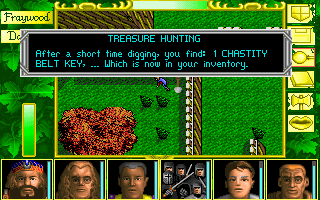From The CRPG Addict
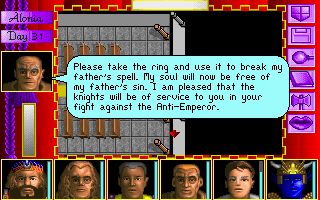 |
| Damn it. This would have been the perfect closing screenshot for my previous entry (“Sins of the Father”). If only I’d played 15 more minutes. |
 |
| Keep sending them, though. They’re good practice. |
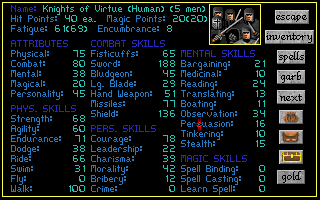 |
| A collective “NPC.” |
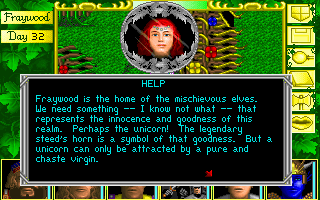 |
| Everyone uncomfortably avoids looking at Chesotor. |
I had to return to the surface to deal with the forest burners. One made me kill him, another wouldn’t leave unless I bribed him, and a third (who said he had always felt guilty about the job) agreed to stop based on a moral argument alone.
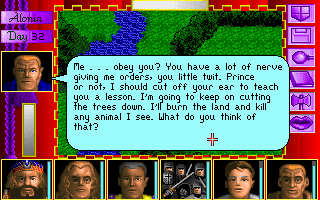 |
| This one was not long for this world. |
Brodo confessed to the entire plot when I confronted him, but he was still dumb enough to take a tankard of ale from me. Soon, he was wetting his pants and unable to control it. Despite the fact that his “revenge prank” was both derivative of and less impressive than the original, King Wilric was overjoyed and joined the party, contributing the third crown.
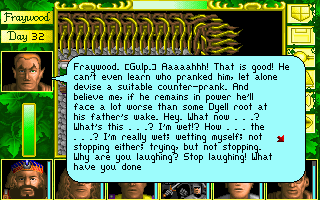 |
| Bathroom humor wins the day. |
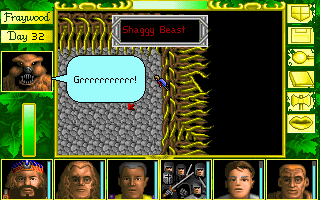 |
| One for you, Tyrnoth. |
I eventually resorted to casting “Truth” spells to figure out who could help me. It turned out to be Rianen, Gwin’s sister, who had been jealous of Gwin’s beauty. Rianen found the directions to the key among her father’s effects, but she couldn’t read it because it was written in an ancient elven language. My Ring of Translation did the trick, although as you’ll see below, it’s unclear exactly how.
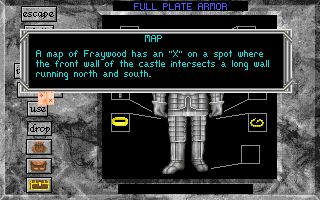 |
| What part of this was “written in an ancient elven language”? |
I dug up the key at the indicated location and returned it to Gwin, who joined the party in gratitude. Assuming she was the virgin needed to lure a unicorn, I wondered how we were going to find a unicorn, but it turned out that I didn’t need to worry: one showed up the moment we left Gwin’s hut. The beast sacrificed itself to allow us to gather it’s horn, an act that I hadn’t imagined was necessary until that moment. I’m reminded of how I didn’t realize that the bull was killed at the end of a bullfight until I was well past the age of 30.
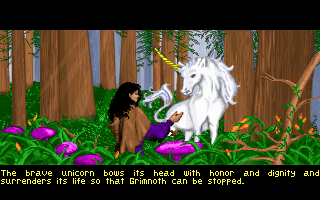 |
| This doesn’t feel good at all. |
Another NPC elf was named “Woody,” had the portrait of Woody Allen, and spoken in Allen-esque quips about his inability to attract women. After a few pages of one-liners (ex: “She hates jokes. I asked her to go for a walk with me in the woods and she said, ‘Don’t make me laugh'”), he gave me his collected Comedic Works. I remembered some gnome back in Alveola who wanted a book of jokes, but upon revisiting the gnome kingdom, I couldn’t find whoever it was.
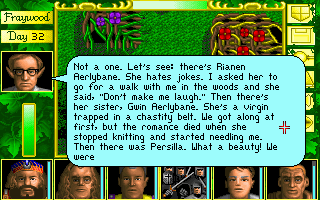 |
| This was a little too on-the-nose. |
We returned to Alonia through the portal and moved on to the next stop in our exploration pattern: the Cathedral of Equus. Our trip was short. The cathedral was completely deserted, and I could find no sign of the monks and nothing to do. Later, in Havenshire, the mother of one of the monks told me of rumors that the monks had turned to sorcery and it was they who had summoned Grimnoth.
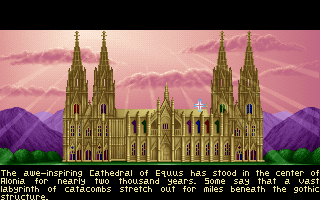 |
| It was a nice graphic, though. |
Thus, we continued on to the harbor village of Galraven, across a narrow channel from Gormond’s castle of Vinazia. I found some shops and spent some time selling amassed equipment and getting some better items for a few of my characters. NPCs told me that Gormond had threatened ship captains against bringing my party to Vinazia. A broke tavern denizen sold me a treasure map for 50 gold pieces; it refers to a bank of a river in a mountain village.
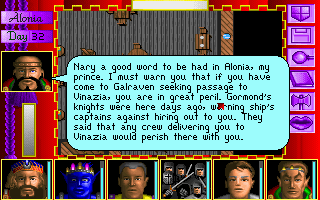 |
| Gormond has apparently never heard of “Teleport.” |
I couldn’t find much else to do in Galraven, so I teleported clear across the map, and slightly north, to the island of Jupiles and its castle, Ventrax. I hadn’t heard much about the location in previous encounters, but it transpired that the island is “ruled” by Emperor Kuvey Lyter. Lyter used to be a friend of my father’s, but the two had a falling out, and Lyter retreated to Jupiles, declaring it an independent state and allowing the practice of magic. The island successfully repelled the first few attempts to take it back, and it appears that Clesodor simply decided to let the matter go.
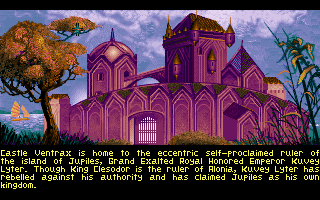 |
| It turns out that Lyter uses the title “emperor” ironically, so it’s okay. |
The kingdom was a weird cross between Oz and a Montessori School, with meandering colorful walkways and a happy populace of “artists, free thinkers, fun seekers, wanderers, and outcasts” allowed “the freedom to grow and learn.” Everyone loved Lyter and no one was unhappy to hear that Clesodor had died except Lyter himself.
The only thing Lyter wanted was knighthood, so he asked me to bring him my father’s knighting sword, which I had fortunately picked up in Castle Duras. In exchange, he gave me two more “group companions”–a set of knights and a set of archers. I had to get rid of Queen Neika and Sir Valakor to accept them. This means that while I have 10 character portraits, I functionally have 22 people with me–more of a “company” than a “party.” These individuals make combat easier but longer, since they’re placed and act individually despite sharing a single portrait.
Lyter has been building a wall to keep out the encroaching darkness, so he asked me to find a supplier for stone and mortar. The game didn’t give me an option to tell him that such a plan was both foolish and futile.
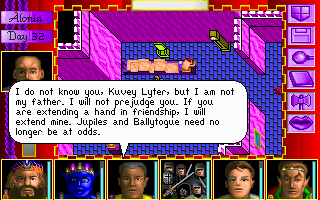 |
| “Together, we might come up with less silly names for our two kingdoms.” |
I consulted the map. The final sequence of visits seemed destined to go as follows: the village of Ragmar, the village of Havenshire, Castle Vinazia, Mount Shaska, and finally the northernmost village of Arinor. I knew I would have to return to Castle Thiris to find the Scrolls of Shamar and bring them to Thornkeep before returning to Thiris again for the endgame, and I suspected there would be some other secondary “return visits” in the meantime. Also, somewhere in that sequence, I’m going to need to find the passage to Aerieus, the final realm.
Ragmar, a dilapidated, vandalized, and suspicious village, turned out to the source of the thieves’ guild who has been raiding surrounding villages. The mayor begged me to find the guild and recover the village’s treasury, which they stole.
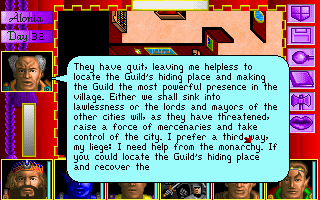 |
| As we’re about to see, I apparently had trouble finding the guild, too. |
One of the NPCs was the wife of Felron, one of the prisoners I released from Monteplai. She begged me to release her husband, but the game gave me no option to tell her that I’d already done so, and I had dismissed him from my party some time ago. This reminded me to remark that a game with this many NPCs needs some central place to organize them. They just disappear when you dismiss them; they don’t return to their original locations.
While I was in Ragmar, the gnome King Amarcam piped up that he had joined my party to help fight Grimnoth, not to solve all the problems of my realm. I thought it was a particularly realistic bit of NPC dialogue. I started to wonder whether I really needed the kings of the other four realms in my party, or whether their crowns were enough.
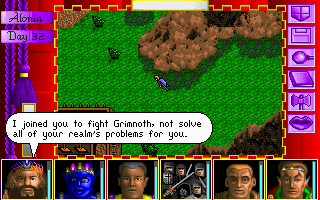 |
| I’ll remember that next time I waste hours on a gnomish murder mystery. |
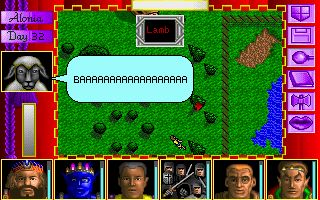 |
| A sheep gives me a new quest. |
In Havenshire, NPC dialogue indicated that their phoenix, normally a protector, has recently gone crazy and started killing the town’s livestock. It is apparently immune to regular weapons. Sure enough, every time we engaged it, it killed my party members one-by-one without suffering any damage.
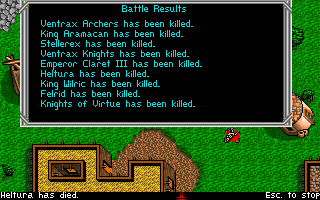 |
| This was a good way to remind myself who’s in the party. I keep losing track. |
One villager told of an ancient hero named Tyro who defeated the beast with the Armor of Valor, the Sword of Malokor, and the Shield of Blotgar. A farmer named Silverfox Tenderfoot said that all the talk of magic items was nonsense, and that the phoenix could be defeated by a giant who lives on Mount Shaska, “the greatest warrior ever.” However, I learned from one NPC that the sword and shield were buried and the map to them entrusted to a “family of sailors that lived in a harbor village,” which sounds a lot like the map I received in Galraven.
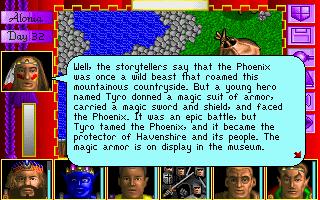 |
| An NPC lays out the problem. |
The Armor of Valor, meanwhile, was in the museum in the center of the town. The curator had hidden the artifact but agreed to give it to me if I could provide “proof that the phoenix can be stopped.” I’m not sure what proof he was looking for, but I didn’t have it. I thought it might be the sword and shield.
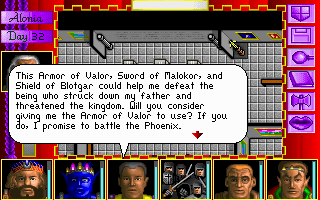 |
| The king bargains for stuff he should just be able to take. |
“South of the watersprings on the bank of the river,” the map had directed. I soon found a pool alongside the bank of the river and dug to the south of it. Oddly, I found not a sword and shield by a diary of someone named Sir Creyar, who discovered that when the phoenix goes mad, it must be killed “in order for it to regenerate into a greater form.” Fortunately, I kept trying and ultimately found the sword and shield more to the southeast than to the south of the fountain.
 |
| Does that shovel look “south” of the fountain to you? |
Nearby, we talked to an NPC and found ourselves in conversation with the Avatar from the Ultima series, who complained of his lot in life. It ended with Chesotor telling him, “You probably have an adventure or two left in you. Rest up. Maybe we’ll meet again someday.” I don’t know exactly what the creators were going for in this encounter. It seems too silly to be serious, too grim to be parody, too detailed to be a simple homage. Maybe they were hoping to get jobs at Origin.
 |
| The poor Avatar has no idea what’s coming for him. |
With the artifacts in hand, I returned to the curator, who gave me the Armor of Valor. I briefly thought of investigating the rumors of the giant, but I realized that to accept him in my party, I’d have to get rid of one of the group “characters,” one of the kings, Felrid (who Cagliostra said I’d need), or one of my powerful spellcasters. I decided to deal with the phoenix myself, but I don’t know what I’m going to do when I meet the King or Queen of Aerieus.
I found and attacked the Phoenix, who died in a single blow.
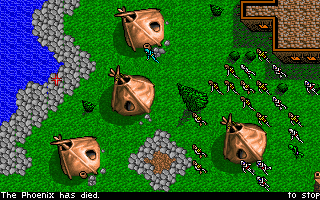 |
| Chesotor fights the phoenix in the upper left, while the rest of the party mills around in the lower-right. |
The curator told me to keep the magic items until I had defeated Grimnoth, then return them so the bird could be killed again when the time came. Other NPC dialogue change to reflect the fact that I had killed the creature, which is a nice touch in this game.
 |
| I’m not sure I’d call the battle “epic.” |
Unfortunately, this session highlighted the exact problem I outlined at the end of the last session: it’s becoming much more an adventure game than an RPG. These seven hours featured no character development and only three combats, two of them against single enemies who died almost instantly. Nonetheless, perhaps more than any other game I’ve played this year, I’m excited to see how the plot resolves for the young King of Alonia. I don’t know about you, but I think it’s time to kill my cousin.
Time so far: 29 hours
Note: I started Realms of Arkania far too early. It was irresponsible to begin it with two games already active and my time so limited by end-of-semester activities. So it’s going to sit on the back burner while I wrap up Challenge and hopefully Camelot. I hope to get to the second entry on the game late next week.
Original URL: http://crpgaddict.blogspot.com/2019/12/challenge-of-five-realms-river-and.html

